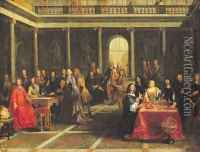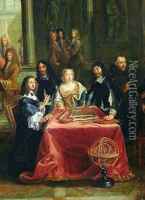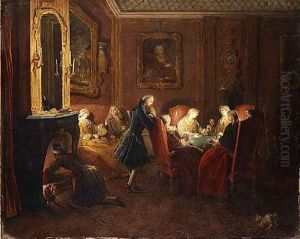Pierre-Louis the Younger Dumesnil Paintings
Pierre-Louis the Younger Dumesnil, also known as Pierre-Louis Dumesnil the Younger, was a French painter born in 1698. He was a member of a family of artists, with his father, Pierre Dumesnil the Elder, also being a recognized painter of his time. Dumesnil the Younger primarily focused on genre scenes, portraits, and religious paintings, although there is some difficulty in distinguishing his work from that of his father due to their similar styles and shared name.
Dumesnil the Younger was active during a period in French art that was transitioning from the grandeur of the Baroque to the more delicate and playful Rococo style. He was a contemporary of artists such as François Boucher and Jean-Baptiste-Siméon Chardin, who were defining French art in the 18th century. Dumesnil the Younger’s genre scenes often depicted daily life with an emphasis on the leisure activities of the French bourgeoisie, which was a popular subject in the Rococo period.
Despite his contributions to French painting, Dumesnil the Younger did not gain the same level of fame as some of his contemporaries. His work, however, was appreciated for its attention to detail and its portrayal of the intimate aspects of everyday life. He exhibited at the Paris Salon, which was the official art exhibition of the Académie des Beaux-Arts in Paris.
Pierre-Louis Dumesnil the Younger passed away in 1781. While his work may not be as widely recognized today, it remains an example of the artistic trends and cultural interests of the French Rococo period. His paintings are part of the collections of various museums and continue to be studied for their historical value and contribution to the development of 18th-century French art.


